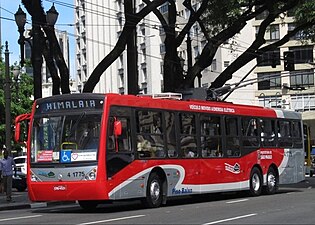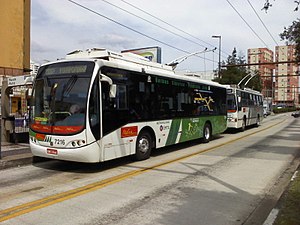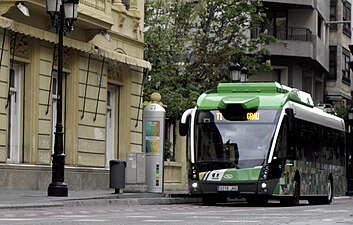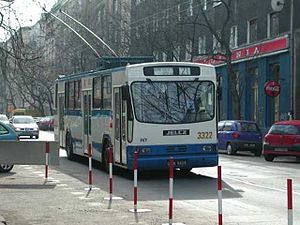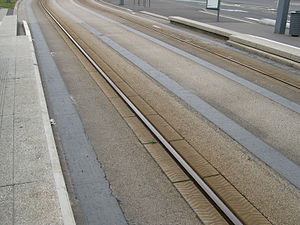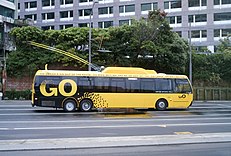Trolleybus
The trolleybus, also known as a trolley or trole, is an electric bus, powered by a catenary of two upper cables from where it takes electrical energy through two poles. The trolleybus does not use special tracks or lanes on the road, like the tram, which is why it is a more flexible system. It has rubber tires instead of steel wheels on rails.
History
The history of the trolleybus begins on April 29, 1882, when Ernst Werner von Siemens runs his Elektromote in a suburb of Bern, which ran until June 13, 1882. The first line experimental, developed by Lombard Gérin, was launched for the World's Fair in Paris in 1900. Max Schiemann took a decisive leap when, on July 10, 1901, he established the trolleybus line for public transport in Bielathal (near Dresden) in Germany.
The trolleybus, as a means of urban transport for practical purposes, originated in the USA at the beginning of the XX century; In 1920, the Brill factory in Philadelphia was already producing trolleybuses, with great acceptance by urban transport companies, due to the great resemblance of its mechanics with the tram and with its overhead line, which allowed company personnel to quickly become familiar with its new material.
The development of the large trolleybus dates to the first decade of the 20th century, when it seemed to be a natural middle ground between the electric vehicles (tram) and gasoline-powered buses. Trolley systems can avoid obstacles on the track that a tram cannot, increasing safety and not requiring the high investment of a tram line. It also offers a transport capacity intermediate between buses and trams (less capacity than a tram, more than a bus) per hour and per direction.
In the United States, oil companies and the automobile industry were sentenced to a federal fine for using bad arts with public and private entities to eliminate trams and trolleybuses and any other type of electric transport, reduction of all types of transport guided, by promoting the private car in urbanizations and all types of road transport, tolerating buses as a lesser evil as long as they did not compete on an equal footing with private transport, and also by reducing rail transport and promoting aviation.
The trolleybus was widely developed in the countries of Eastern Europe or the USSR, where they were implemented in almost all cities with more than 200,000 inhabitants.
Some public transportation companies, starting with New York's Brooklyn-Manhattan Transit Corporation (BMT), enunciated the concept of all-four. That is, the use of buses, trolleybuses, trams and metros as an integrated and complementary system between the lightest and heaviest systems. Buses and trolleybuses in particular were considered a short-distance system that completed other longer-distance and faster systems, such as the subway, light rail, or urban train.
Schematic of a trolleybus
Schematic of a trolleybus, showing in this case a Pullman Standard 43-CX No. 814, the oldest trolleybus in the world still in operation in the city of Valparaíso, Chile.
Advantages and disadvantages
Advantages
- Trolleybuses are of particular importance for steep or mountainous cities, where electricity is more effective than diesel when it comes to climbing hills; they also have greater adherence than trams.
- Trolleybuses, like all electric vehicles, are often seen as a means of transport more environmentally friendly than combustion buses, which consume hydrocarbons and emit gases. The use of energy produced in power plants has advantages over the explosion engines: it is more efficient, can use greater variety of fuels and is more convenient for pollution control and the heat generated can be reused by providing hot water for all types of uses (industries, hospitals, sports facilities), or cold generation with absorption equipment. In any case, renewable electricity can also be used.
- Another advantage that is rarely present in other vehicles (except for some hybrid tourism) is that they can generate electric energy from kinetic energy when they slow or go down in a process called regenerative braking.
- It has been suggested that trolleybuses will become obsolete in a hydrogen economy, which has never just arrived. However, the direct transmission of electricity, such as the one used in the trolleybus, is much more efficient than the production, transport, storage and energy use of hydrogen in fuel cells in a factor of 2.2 to 1, and much less dangerous.
Disadvantages
The trolleybus shares advantages with the tram and the bus but also some disadvantages:
- If the trolleybus accidentally separates from the catenary, it stops. For the same reason, the possible routes are limited to the sections with installed catenarias. However, a conventional battery or thermal engine can be incorporated to allow greater versatility.
- The tires produce more resistance than the metal wheels on the lanes and, therefore, a higher cost of electricity compared to a tram.
- If an electric blackout occurs suddenly, it will not work (unless they have a backup source like an inertial battery or an auxiliary engine).
Switches (turnouts)
Trolley bus line switch
Overhead trolleybus line switches (referred to as "branches" in some countries) are a standard part of the equipment in places where one trolleybus line branches or branches into two. A switch can be “straight on” on lines that clockwise turn is desired, or “straight off” if it is desired to go straight unless actuated, and automatically reverts after a few seconds. Actuation is often caused by a pair of contacts or electromagnets, with one attached to each phase of the wire, located near but before the switch itself. (It would be the other way around for cases of turning to the left, establishing the standard mode depending on whether the preference is to continue straight or to make the turn.
The three most common types of switch are Power-on/Power-off, Selectric, and Fahslabend.
- 1.o Energy-on/Energy-off switch is triggered if the trolleybus is taking airwire energy, usually accelerating, when the poles pass over the contacts. (The contacts line up in the wires in this case).
- 2. A Selectric switch has a similar design, but contacts in the wires are not aligned but biased, often at a 45-degree angle. This oblique position means that a right-handed trolleybus will not trigger through the switch, but a trolleybus that seeks a sharp turn (usually a right turn in right-traffic countries) will make its poles solve the wires in an oblique position that matches one pole in front of the other, which will trigger the switch. (This system is the classic used in trolley trams because by being guided by the rails the vehicle drags the trolley in its same direction and pushes the slide against the switch causing the phyllline change).
- 3.o For a Fahslabend switch, the trolleybus turn indicator (or a separate controlled switch) causes an encrypted radio signal to be sent from a transmitter mounted on the trolleybus (often linked to one of the poles of the pertigue). The corresponding receiver is attached to the switch directly, and will cause it to the trigger if the correct code is received. This has the advantage that the driver does not need to speed up the trolleybus (such as Energy-on/Energy-off) or try to make an acute spin (such as with a Selectric switch). Consequently, many cities in which trolleybuses operate have replaced other types of Fahslabend switch.
Crosses
There are several types of overhead line crossings, simple, perpendicular and oblique and also multiple only filovias or filovia-filolinea (trams) the latter are different if the tramway crossing uses a trolley or pantograph the latter are usually oblique to thus not lose power to the vehicles at any time.
Gallery
Guided trolleybus
It is a hybrid between the tram and the trolleybus, which travels on tires on the normal road, but guided by a central lane embedded in the pavement.
In Caen (France) they have arranged a one-way tram with tires and a central guide rail, tram supply with a wire line, a wire and a pantograph with a return through the rail. It has a diesel generator for your return to the garage without a guide, which is why for French legislation it is a bus.
In Nancy (France) they have a similar system but powered by wire track and double trolley, so it can circulate in electric mode with or without guidance, it also has a diesel engine for changing direction where there is no loop and to take it to depots, the guide rail is incompatible with that of Caen. It is also legislated as a bus. The disadvantage of these two systems is that both have only one manufacturer and the operator cannot go to the market for trams and trolleybuses in search of the best price or benefits (contests).
Bombardier, the manufacturer of the Caen and Nancy systems, stops producing both (it is really the same system in two variants), because it is not profitable for them to maintain a product that only two cities use, so they are studying adopting the Translorh, for which they have contacted Lorh, to study the transformation that will require changing the entire guide rail and to study the feeding in the case of Nancy, (the latter has unguided sections in commercial exploitation), it seems very expensive considering that the The only city that uses it, thinks about installing a conventional tram.
Trolleybus and Tram
Catenary
The trolleybus can use a common three-wire catenary with the tram.
Tram on tires
In Clermont-Ferrand they have adopted the Translohr, a two-way tram on tires, similar to the Caen system but that only works in electric mode and can in no way operate without guidance, for which reason the vehicle lacks both a steering wheel, mirrors and car lights like license plates. Apparently it will be closed at the end of its useful life and replaced by a traditional tram with rail guidance and buses/trolley buses with optical guidance.
Optical orientation
There is also an optical guidance system being tested that uses simple marks painted on the ground and an optical system (laser or artificial vision).
In Castellón, the TVRCAS is already operating a guided trolleybus with a diesel generator to power its electric motors integrated into the vehicle's tires and to be able to circulate if necessary without a filovia. It uses laser guidance with road markings and exclusive platform, but it can drive just fine without them.
Some trolleybus manufacturers
Europe:
- Breda, Italy
- Hess (Switzerland)
- Ansaldo, Italy
- Kiepe Electric (only electrical components)
- Hispano Carrocera (carrocerías)
- Marcopolo (workshops)
- BTZ (Russia, integral)
- ZIU/Trolza (Russia, integral)
- Skoda
- Ganz Transelektro + Solaris electrical equipment Ganz
- Volvo
- Man
- Mercedes Benz
- Alfa Romeo Fiat
- British United Traction
- ABB (electric equipment)
Asian:
- Guantong Bus
- Yutong (China)
America:
- Eletra (Brazil - electrical equipment)
- Caio Induscar (Brazil)
- WEG (Brazil, electrical equipment)
- EPTM (Provincial Transport Company of Mendoza) and Materfer (Argentina)
- DINA (Diesel Nacional)
- New Flyer
Curiosities
The world's longest trolleybus line, with a length of 86 km, connects the Ukrainian city of Simferopol with Yalta, on the Black Sea coast.
The oldest fleet of this type of vehicle, as well as the longest-running machine in operation, circulates through the streets of the Chilean city of Valparaíso.
Trolleybuses in the world
There are currently about 315 cities or metropolitan areas where trolleybuses still operate, and more than 500 additional trolleybus systems have existed in the past. For a complete list of local trolleybus systems, with opening and (if applicable, closing) dates, see the list of trolleybus systems and related listings listed there.
In different countries of the world there are cities that have trolleybus services.
In South America, for example, many cities have electric bus services to this day, and others did in the past (such as Montevideo, Uruguay).
Africa
There are currently no trolleybus systems, but in the past, trolleybuses have served several cities in South Africa, as well as two cities in Algeria, three in Morocco, one in Tunisia, and one in Egypt. The last city on the mainland to have a trolleybus service was Johannesburg, whose system closed in 1986.
America
- Argentina In Mendoza the first trolleybus line of the country was inaugurated in 1913, a few days before the inauguration in Buenos Aires of the first subway line of the southern hemisphere. There are three other cities that currently have trolleybus services. The trolleybus system of the city of Cordoba has existed since 1989 and has three lines: A, B and C. Other cities that have their own network are Mendoza, which has four lines and its service was opened in 1958. With line K and line Q (since 2017), the city of Rosario has its trolleybus network, also since 1958; in the past, there were also lines G, H, J and M in Rosario, all disappeared during the 70s and 80s. The cities of Mar del Plata, Buenos Aires and La Plata had trolleybus lines at the time, but in the face of their economic deficit they stopped working. Recently, it began to seek to operationalize this means of transport in the city of Florencio Varela taking advantage of the fact that Russian companies Kamaz S. A. S. and Trolza S.A. will install a plant in the Industrial and Technological Park of that district.
- Brazil has three different networks: two systems (separated from each other) in São Paulo and another in Santos. The system of the city of São Paulo was created in 1949 and operates until today. In 2000, the city had the longest trolleybus network in the southern hemisphere, with 559 vehicles and a network of 326 km of extension. The city of São Paulo currently has 201 modern trolleybuses in operation, with 51 of them with batteries that allow their operation disconnected from the cables for up to 7km.
- In Canada, only the cities of Vancouver, Laval and Montreal have trolleybus networks. The city of Edmonton had a system until May 2009.
Several other Canadian cities have operated trolleybus systems in the past. In Hamilton, they were used from 1951 until late 1992. Toronto initially had an experimental fleet of four trolleybuses from 1922 to 1927, but later maintained a fleet of about 150 vehicles from 1947 to 1992. Another 40 trolleybuses leased from Edmonton continued the operation in Toronto until the contract expired in July 1993, and the buses were returned to Edmonton a few months later. Most trolleybus systems elsewhere in Canada were abandoned during the 1960s and 1970s, the last two to disappear at that time (Saskatoon and Calgary) closing their doors in 1974 and 1975, respectively.
- Colombia. In the country it was the two main cities that used trolleybuses. Medellin was the first Colombian city to employ trolleybuses as the tram service had been closed. Medellin's trolleybus service began on October 12, 1929 on Route 6, which served the Los Angeles district. Nine trolleybuses were running on two routes in Medellín when the TMM suspended all electric transport in 1951. It is currently planning to build a 12 km line in the Municipality of Bello (member of the Metropolitan Area of the Aburra Valley and integrate it to the SITVA and the Metro System of Medellín). Bogotá, followed Medellin with the implementation of the trolleybus. was able to have its trolley system that was in service between 1948 and 1991. It was operated by the District Urban Transport Company (EDTU), liquidated in the early 1990s.
- In Chile, the only city where a trolleybus service operates is in Valparaiso. The service has been in operation since 1952 and is the second oldest trolleybus network in Latin America. Since 2007, the system has been administered by Trolebuses of Chile S. A., within the framework of the Metropolitan Transport system of Valparaiso. The fleet has the trolleybus No.814, a Pullman Standard 43-CX of 1947, the oldest in the working world.[chuckles]required]
- In Ecuador, Quito is another one that also has trolleybuses in its public transport system. Since 1995, the city of Quito has more than 20 kilometres of network and six lines.
- In the United States, since the opening of the first system, they had a relatively short life. The first network has operated since 1910 in Los Angeles, and from there, more than 60 cities in the country have been treated by trolleybuses, in some cases by two or more independent systems managed by different private companies.
Today, five cities (and in cases, their metropolitan areas) have trolley systems: Boston and its suburban city of Cambridge; Philadelphia; San Francisco; Seattle and Dayton.
- In Mexico, the Trolebus Network of Mexico City is one of the largest in the continent: it has 261 kilometers of network, which is perfectly integrated with the other transport systems along the route of its ten lines. On the other hand, Guadalajara has a trolleybus line operated by SITEUR, which is also responsible for the light train service in the city.
- In Uruguay, the city of Montevideo had a wide public system of trolleybuses that replaced the tram in the 1950s. This system operates until 1975 when it comes to a cooperative. In the 1990s the system would be dissolved.
- In Venezuela there is a single system that qualifies in trolleybus: Trolmérida in the city of Merida with 18.2 kilometers of network.
Asian
- Armenia has 24 operating lines of trolleybuses in the city of Yerevan since 1949, installed during the communist government of the USSR.
- China has more than 27 cities with trolleybus routes: Shanghai, the oldest operating service since 1914; Beijing, among others, has one of the most extensive networks.
- In North Korea there is a trolleybus network in Pionyang, which has about 57 kilometres long, and connects the city with some suburbs.
- In India, some of its cities had trolleybus service, one in New Delhi (between 1935 and 1962) and another Mumbai (between 1962 and 1971).
- For its part, Iran has had a network in Tehran since 1992.
- Seven cities in Japan had urban services. At present, there are only two lines of tourist use that cover mountainous areas.
- Mongolia is another country with a trolleybus network, introduced in this nation during the period of industrialization of the USSR.
- Nepal operated a route between 1975 and 2001, resumed in 2003 with the objectives of expanding it and failed, so the country was left unabated in 2009.
Europe
- In Spain we can mention the TRAM service that is provided in the city of Castellón where there is only one line.
Other cities with active trolleybus networks are: Minsk (Belarus); Parma (Italy) as in 13 other cities; Zurich (Switzerland) and 12 other locations; Salzburg (Austria); Sarajevo (Bosnia and Herzegovina); various cities in Bulgaria; thirteen networks in the Czech Republic; four cities in France; three cities in Germany operate services in a country that had 60 networks; Athens, Greece); Budapest, Hungary); Gdynia, Lublin and Tychy (Poland) among other countries.
In countries like Belgium, Denmark, Estonia or Finland, trolleybus networks have been supplanted by trams or diesel buses.
Oceania
- Only New Zealand has a current tingling in Wellington. This network has nine lines. In the past, there were trolleybuses in Australia, in the cities of Adelaide, Brisbane, Hobart, Launceston, Perth and Sydney.





